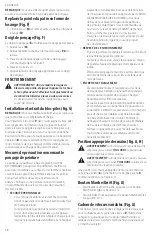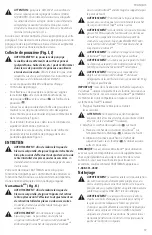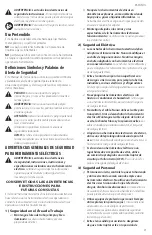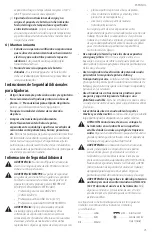
9
English
Proper Hand Position (Fig. A, H)
WARNING:
To reduce the risk of serious personal injury,
ALWAYS
use proper hand position as shown.
WARNING:
To reduce the risk of serious personal injury,
ALWAYS
hold securely in anticipation of a sudden reaction.
Precautions to Take When Sanding Paint
Sanding of lead based paint is NOT RECOMMENDED due
to the difficulty of controlling the contaminated dust.
The greatest danger of lead poisoning is to children and
pregnant women.
Since it is difficult to identify whether or not a paint contains
lead without a chemical analysis, we recommend the
following precautions when sanding any paint:
1.
PERsOnAl sAFETY
‑
No children or pregnant women should enter the
work area where the paint sanding is being done
until all clean up is completed.
‑
A dust mask or respirator should be worn by all
persons entering the work area. The filter should be
replaced daily or whenever the wearer has difficulty
breathing. See your local hardware store for the
proper NIOSH‑approved dust mask.
‑
NO EATING, DRINKING or SMOKING should be done
in the work area to prevent ingesting contaminated
paint particles. Workers should wash and clean up
BEFORE eating, drinking or smoking. Articles of food,
drink, or smoking should not be left in the work area
where dust would settle on them.
2.
EnViROnMEnTAl sAFETY
‑
Paint should be removed in such a manner as to
minimize the amount of dust generated.
‑
Areas where paint removal is occurring should be
sealed with plastic sheeting of 4 mils thickness.
‑
Sanding should be done in a manner to reduce
tracking of paint dust outside the work area.
3.
ClEAning AnD DisPOsAl
‑
All surfaces in the work area should be vacuumed
and thoroughly cleaned daily for the duration of
the sanding project. Vacuum filter bags should be
changed frequently.
‑
Plastic drop cloths should be gathered up and
disposed of along with any dust chips or other
removal debris. They should be placed in sealed
refuse receptacles and disposed of through regular
trash pick‑up procedures. During clean up, children
and pregnant women should be kept away from the
immediate work area.
‑
All toys, washable furniture and utensils used by
children should be washed thoroughly before being
used again.
To remove the battery pack from the tool, press the release
button
8
and firmly pull the battery pack out of the tool
handle. Insert it into the charger as described in the charger
section of this manual.
Installing and Removing the Battery Pack
(Fig. G)
nOTE:
For best results, make sure your battery pack is
fully charged.
To install the battery pack
7
into the tool handle, align the
battery pack with the rails inside the tool’s handle and slide it
into the handle until the battery pack is firmly seated in the
tool and ensure that it does not disengage.
OPERATION
WARNING: To reduce the risk of serious personal
injury, turn unit off and remove the battery pack
before making any adjustments or removing/
installing attachments or accessories.
An
accidental start‑up can cause injury.
Finger Attachment (Fig. F)
The finger attachment
6
is used for fine detail sanding.
1. Remove the screw
13
.
2. Remove the diamond‑shaped tip holder
4
from the base.
3. Fit the finger attachment onto the sanding base as
shown in Figure F.
4. Fit and tighten the screw.
5. Align the appropriate sanding sheet
10
with the
finger attachment.
Replacing Diamond Shaped Pad Tip (Fig. F)
When the sanding base tip
12
or tip holder
4
is worn, it
can be reversed or replaced. Spare parts are available from
your dealer.
1. Remove the screw
7
.
2. Reverse or replace the worn part.
3. Fit and tighten the screw.
Attaching Hook and Loop Sanding Sheets
(Fig. D)
For best results, use CRAFTSMAN accessories.
• To attach the sanding sheet
10
, carefully center the sheet
over the sanding pad
5
ensuring the holes in the disc align
with the holes in the pad and press the sheet firmly in place.
• The hook and loop fastening system sanding sheet
can be easily removed by simply pulling it off. It can be
reused as desired.
Sanding Sheet Tips (Fig. D)
• Detach the two additional diamond‑shaped tips
11
from the sanding sheet
10
nOTE:
The diamond‑shaped tip can be reversed and
replaced when worn.
• When the front part of the tip is worn, detach it from the
sheet, reverse it and press it onto the diamond‑shaped pad
tip
12
again.
• When the whole tip is worn, remove it from the sanding
base and fit a new tip.
nOTE:
For optimal dust collection, ensure the correct type of
sanding paper is used.
Summary of Contents for CMCW221
Page 5: ...3 Fig G Fig H Fig I Fig K Fig J 7 8 14 15 16 17 18 19 20 ...
Page 33: ......
Page 34: ......
Page 35: ......












































